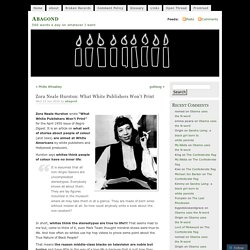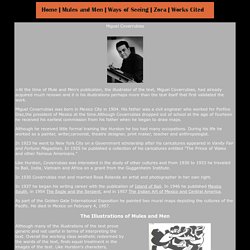

Blaxploitation.com. Zora Neale Hurston: What White Publishers Won’t Print. Wed 23 Jun 2010 by abagond Zora Neale Hurston wrote “What White Publishers Won’t Print” for the April 1950 issue of Negro Digest.

It is an article on what sort of stories about people of colour (and Jews) are aimed at White Americans by white publishers and Hollywood producers. Hurston says whites think people of colour have no inner life: It is assumed that all non-Anglo-Saxons are uncomplicated stereotypes. Everybody knows all about them. In short, whites think the stereotypes are true to life!!!
That means the reason middle-class blacks on television are noble but boring and have little in the way of a love life is because that is just how they seem to white screenwriters! Or take “Shaft” (1971): the hero, “a sex machine to all the chicks” as we are informed in the opening song, has sex with three women but loves none of them – he even pointedly avoids the L-word. Revue Gradhiva 2014/1, « L’Atlantique Noir » de Nancy Cunard. Zora Neale Hurston: An American Story. Note: This post is a collaboration between Burt Likko and Chris.

Burt wrote a biography of of Zora Neale Hurston for submission to his local secular group’s newsletter. Chris wrote a celebration of Zora Neale Hurston as one of America’s most eloquent and powerful writers. All quotes herein are from Hurston, unless otherwise indicated. Zora Neale Hurston may very well be the greatest American novelist whom you have not read. Hurston/Wright Foundation. Marita Golden Founder and Interim Executive Director The Zora Neale Hurston/Richard Wright Foundation is a resource for a world of Black writers and the readers who love them.

We have a new look that enhances our mission and message and helps us better serve authors, publishers and readers. For 25 years, the Hurston/Wright Foundation has served a community of Black writers. In this anniversary year, we are expanding our ability to connect with Black writers and readers who love literature inspired by the global Black experience. Because we understand that you want to know more about authors and their literary works, our new website makes the Hurston/Wright Foundation one of the best resources for information on Black writers. Author Pages feature information on authors’ backgrounds, book titles and awards, as well as links to purchase books.The Legacy Awards Archives features past nominees, winners, finalists, and College Writer Award recipients.
Zora's Place. On a mid-August day with a heat index of 115 degrees, in a rental car with slow pickup, I drive through the Orlando suburbs searching for Eatonville, a three-square-mile town of 2,400 residents.

I keep getting lost. Finally a brown “Eatonville Historic District” sign appears, and fifteen miles later it dawns on me that I have gone too far. I turn back, find the city limits, and enter Eatonville. At the “Welcome to Maitland” sign, I realize I have driven through the entire town. It took three minutes. It may be small and hard to find, but Eatonville is important for two reasons: It was the first all-black incorporated town in the United States, and it was the childhood home of Zora Neale Hurston. Formed after the signing of the Emancipation Proclamation, Eatonville was named after Josiah Eaton, a white army captain living in Maitland. Hurston Zora Neale - Library System - Howard University. In 1918, Hurston graduated from Morgan College in Baltimore, Maryland.

She then studied at Howard University from 1918 to 1924. Lorenzo Dow Turner, Alaine Locke, and Georgia Douglas Johnson were some of her mentors as she studied and developed her writing skills. Hurston received a scholarship in 1925 to attend Barnard College in New York City where she studied anthropology under Franz Boas. She received the Rosenwald Foundation Fellowship and studied for two years at the Columbia University Graduate School. The Harlem Renaissance was in full swing when Hurston arrived in New York City. She began her field research in Alabama by interviewing an ex-slave by the name of Cudjo Lewis. At the time of her death, Hurston's star had faded. She continued to write and was able to sell articles to some of the national magazines, but she never published another book. Zora Neale Hurston's Mules and Men and E-Project: Miguel Covarrubias. >At the time of Mule and Men's publication, the illustrator of the text, Miguel Covarrubias, had already acquired much renown and it is his illustrations perhaps more than the text itself that first validated the work.

Miguel Covarrubias was born in Mexico City in 1904. His father was a civil engineer who worked for Porfino Diaz,the president of Mexico at the time.Although Covarrubias dropped out of school at the age of fourteen he received his earliest commission from his father when he began to draw maps. Although he received little formal training like Hurston he too had many occupations. During his life he worked as a painter, writer,caroonist, theatre designer, print maker, teacher and anthropologist. Voices From the Gaps : University of Minnesota.